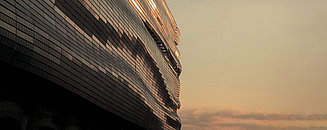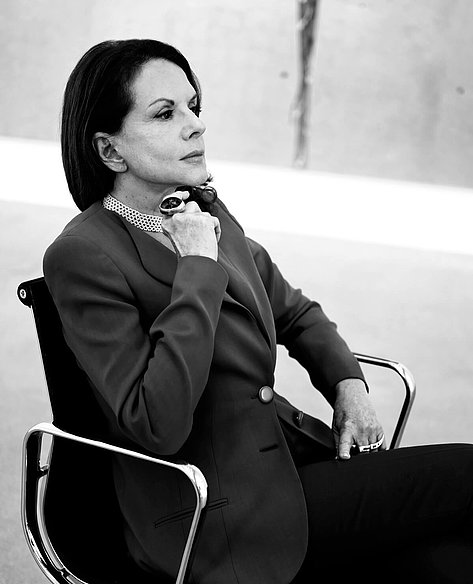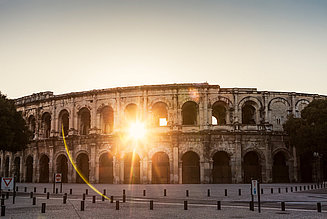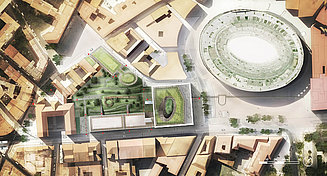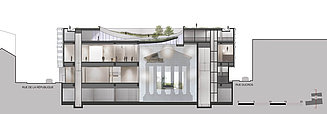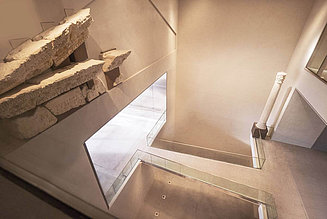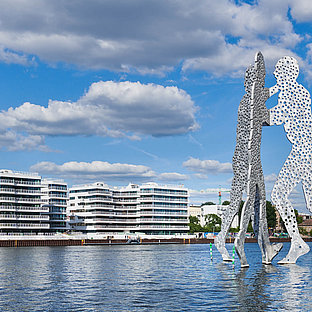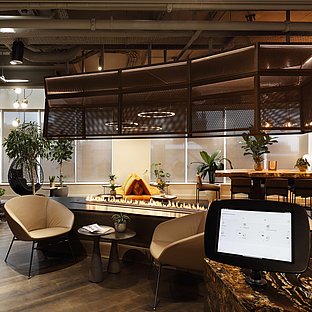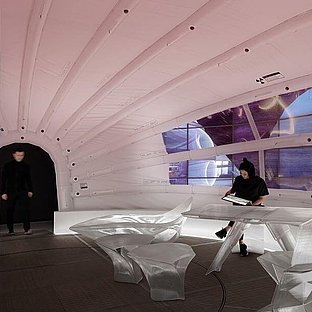Rendezvous with Antiquity
13 min readNîmes: Roman history wherever you look
In the centre of Nîmes stands a restored Roman temple (the Maison Carrée), opposite which is the Carré d’Art, designed by Norman Foster and housing a museum of modern art and a library. Close by is the Roman city gate – the Porte d’Auguste – and the castellum aquae, which used to serve as a water distributor. Only one other comparable castellum aquae has been preserved: in Pompeii. In the expansive grounds of the Jardins de la Fontaine rises the Tour Magne – originally built in pre-Roman times but expanded into a fortified tower by the Romans.
Another example of Roman architecture in the park is the Temple of Diana. In light of this concentration of Roman architecture, it is no wonder that every year in April, Roman legionnaires, imperial entourages, and riders on horseback and in chariots take over the city for an entire weekend, recreating the days of antiquity – over 500 participants from France, Italy and Germany travel here for the event. The main venue is the amphitheatre that can accommodate up to 24,000 people. The city centre, too, is filled with costumed parades, guided tours and much more.
The architect – Elizabeth de Portzamparc
An architect and an urbanist, Elizabeth de Portzamparc designs buildings that are both architectural symbols and powerful urban landmarks, which skillfully structure the locations in which they are built. Her architecture aims to create stimulating neighbourhoods that improve their inhabitants’ quality of life. Her buildings highlight the qualities of the contexts into which they are inserted, and enter into dialogue with their urban environment. Yet her architecture is mostly sober, light and streamlined – economical in its use of forms and materials. Her approach combines the demands of a particular social, urban and ecological context with the creation of optimal forms.
Besides architects, urban planners and set designers, her firm employs an interdisciplinary team that specialises in environmental and social issues. For decades, she has been conducting research into regional identity, community life, and territorial ties, making a significant contribution towards contemporary thinking on urban development. In this context, she has already made pioneering contributions to the mixed use of urban spaces and sustainable, flexible living.
Museum of Roman History in Nîmes
In Roman times too, the city enjoyed more prominence than it does today – its ancient defensive walls stretching for seven kilometres were the mightiest in all of Gaul, and the Roman city, known then as Colonia Nemausus, was at least four times as big as the later medieval city. Its most important Roman buildings date from the time of Agrippa, son-in-law of the emperor Augustus, who in 27 BCE was instrumental in the settlement’s elevation to the status of Colonia. Since 2018, the city’s Roman history can be traced in the new Museum of Roman History, located right next to the well-preserved amphitheatre – an architectural encounter of a very special kind…
Designed by architect Elizabeth de Portzamparc and her firm 2Portzamparc, the new museum contrasts strikingly with the Roman monument and also forms an entranceway, which leads through an ornately laid-out garden to the building complex behind it. This 3,500-square-metre garden was designed by landscape artist Régis Guignard. On three levels, he has arranged plants typical of three different epochs – Gallic, Roman and medieval. A partially green roof terrace affords a fantastic panoramic view of the old city and its buildings from Roman times.
The architecture of the museum itself is arranged around the 17-metre high atrium with its double helix spiral staircase and a restored Roman fountain. The exhibition areas are grouped around this inner courtyard on three ingeniously interlinked floors of the museum, featuring over 5,000 exhibits in the permanent exhibition alone and inviting visitors to embark on a journey through 25 centuries of history. Digital reconstructions of buildings and entire districts complement the visitor’s experience. In addition, three white backlit “knowledge boxes” shed light onto historical contexts on monitors and timelines. From the exhibition rooms, visitors also enjoy views of the city outside that includes, above all, the view of the Roman amphitheatre.
According to Elizabeth de Portzamparc, the façade of the museum with its shell structure consisting of 7,000 opaque, screen-printed glass squares is inspired by the folds of a Roman toga, contrasting with the rigorous contours of the Roman monument. When the light falls at the right angle through the seemingly weightless glass platelets, the supporting steel construction beneath may sometimes be seen. The folds of the “toga” also afford occasional glimpses of the museum’s interior as some of them are fitted with transparent glass. The building’s modern architecture has certainly aroused controversy in Nîmes.
The new Museum of Roman History in Nîmes was opened in June of 2018. We spoke with its architect Elizabeth de Portzamparc about her thoughts on the Musée de la Romanité, the development of its unique architectural style, and her current projects.
Mme de Portzamparc, which museum did you last visit?
The Neues Museum in Berlin. Here an interesting dialogue is taking place between recalling the earlier building and the current project – very appropriate for a historical museum.
What, in your opinion, does a good museum building have to achieve?
It must be suitable for the field it covers and its contents. As an institution, the building must be accessible to the city’s public. Beyond that, it must be characterised by the quality of the relationship it creates between the art works on show and the public.
Our magazine focuses on “encounters”. How would you describe the encounter between the Musée de la Romanité and the Roman amphitheatre?
In this urban context, I have set up a complementary relationship between the two pieces of architecture. Without any reference to the architecture of the past, the juxtaposition allows each building its freedom and its own modernity without rivalry. The contrast creates an architectural tension between the two buildings that enhances the whole area. A dialogue is thus created through complementarity.
What was the assignment you received from the city?
The commission of the City of Nîmes can be divided into four subtasks. First of all, the museum had to be built at a specific location, on the “Green Block” in front of the old amphitheatre. Secondly, the building had to engage in a contemporary dialogue with the amphitheatre. Thirdly, it was very important that the museum be defined as an urban space and not as an isolated building – that is, it had to be open to the city. For this reason, we decided to create the “inner street” and an archaeological garden that were not included in the original assignment. Finally, the heart of the commission was to build a new museum to house the Archaeological Museum’s collection, since it could no longer be satisfactorily displayed at its old location. Archaeological excavations on the Boulevard Jaurès had brought to light a number of new Roman domus (city houses) and mosaics that deserved to be displayed at a new location.
How would you describe your first encounter with this location after you had learnt of the design task?
Immediately after the finalists for the competition had been announced, and without wanting to wait for a statement from the city authorities, I travelled to Nîmes to investigate the site. At this point in time, the location of the new museum was settled on, as were its three main features: the exhibition rooms, an archaeological garden, and an administrative building. I didn’t need anything else to get on with my work – especially with such a world-famous location as my starting point, one that featured a monument radiating such strong, evocative energy. The Roman amphitheatre candidly displays its riches – its elliptical sequence of arcades whose dynamism, modernity and insolence never cease to amaze one. But faced with this abundance of riches, it was also necessary to distance myself from their influence and give my fantasy free rein, so that I could create a contemporary architectural style unique to the museum.
What significance does the concept of encounter hold in your museum?
All my works are based on the principle of an “architecture of relationships” between a building and its outer and inner setting. This includes historical, geographical, spatial, sociological, cultural, symbolic, morphological, sensory, and many other kinds of relationships. Your material and conceptional realisation is evident in every architectonic element of the Musée de la Romanité: the façade, which reflects the city and the sky; the atrium, the geographical heart of the museum that expands the city’s public space; the museum garden; and the exhibition that extends from the esplanade of the amphitheatre to the roof of the museum building.
Which (famous) person would you like to encounter on your way through your museum?
Claude Levi-Strauss, or if I have to be more realistic: Philippe Descola.
The goal of contemporary architecture is freedom from the constraints of gravity and the earth. I was thus convinced that the museum building had to express this striving for airiness – to the extent that it appears to float above the esplanade. But while making my preliminary sketches and walking through the city, I recognised the necessity of giving the museum an accessible roof garden – an area that was not included in the original plan. In Nîmes, the Tour Magne is the best place to go for panoramic views. It affords a view of the whole city, in particular of the museum. It was obvious that we had to turn the museum into a lookout point as well, linking it to the tower and providing a panorama of the entire historical inheritance of Nîmes. In order to do full justice to our principle of an “architecture of relationships” and to meet the needs of an open museum, we decided to make the roof terrace fully accessible – including to people who are not visiting the museum.
How do you see your creation in the context of Roman and modern buildings in the immediate neighbourhood?
A building to house the Roman collections across from the amphitheatre had to be absolutely contemporary in design. It had to be a building that makes an impact on the cityscape while harmonising with the immediate neighbourhood. Juxtaposing old and contemporary architecture, and thus creating contrasts in the cityscape, is a speciality of Nîmois cultural policy. The city fosters the vision of a living inheritance stretching from antiquity to the present, an inheritance whose modern spirit is evoked each time a new architectural object is created. Coming from a land of contrasts – Brazil – I was not daunted by the task of creating a dialogue between two buildings separated by twenty centuries of architectural history. On the contrary, it was an extremely exciting perspective, a wonderful architectural challenge that I was ready to accept without hesitation.
What are you working on at the moment?
Amongst other things, right now I’m working on the Science Hall of Zhangjang Science City in Pudong (China). The location is part of the Shanghai Park Project, which aims to restructure the city’s ring road with a greenbelt. In Taichung (Taiwan) I’m working on the Taichung Intelligence Operations Center. It was conceived as a sustainable, urban, people-oriented neighbourhood project that will have a population of thousands. Then I’m preparing for the 27th World Congress of the International Union of Architects in July 2020 in Rio, for which I am a member of the honorary committee. Urbanists, engineers, architects, and political decision-makers from all over the world will meet to discuss the creation of social habitats and to develop proposals for the future of our cities. In addition, I’m working on a new book that focuses on 18 of my projects since the nineties.
Photos: Serge Urvoy, 2Portzamparc (Renderings), benkrut / istockphoto
